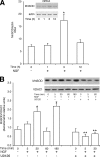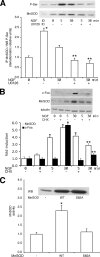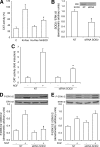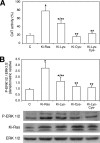Reactive oxygen species, Ki-Ras, and mitochondrial superoxide dismutase cooperate in nerve growth factor-induced differentiation of PC12 cells
- PMID: 20495008
- PMCID: PMC2911279
- DOI: 10.1074/jbc.M109.098525
Reactive oxygen species, Ki-Ras, and mitochondrial superoxide dismutase cooperate in nerve growth factor-induced differentiation of PC12 cells
Abstract
Nerve growth factor (NGF) induces terminal differentiation in PC12, a pheochromocytoma-derived cell line. NGF binds a specific receptor on the membrane and triggers the ERK1/2 cascade, which stimulates the transcription of neural genes. We report that NGF significantly affects mitochondrial metabolism by reducing mitochondrial-produced reactive oxygen species and stabilizing the electrochemical gradient. This is accomplished by stimulation of mitochondrial manganese superoxide dismutase (MnSOD) both transcriptionally and post-transcriptionally via Ki-Ras and ERK1/2. Activation of MnSOD is essential for completion of neuronal differentiation because 1) expression of MnSOD induces the transcription of a neuronal specific promoter and neurite outgrowth, 2) silencing of endogenous MnSOD by small interfering RNA significantly reduces transcription induced by NGF, and 3) a Ki-Ras mutant in the polylysine stretch at the COOH terminus, unable to stimulate MnSOD, fails to induce complete differentiation. Overexpression of MnSOD restores differentiation in cells expressing this mutant. ERK1/2 is also downstream of MnSOD, as a SOD mimetic drug stimulates ERK1/2 with the same kinetics of NGF and silencing of MnSOD reduces NGF-induced late ERK1/2. Long term activation of ERK1/2 by NGF requires SOD activation, low levels of hydrogen peroxide, and the integrity of the microtubular cytoskeleton. Confocal immunofluorescence shows that NGF stimulates the formation of a complex containing membrane-bound Ki-Ras, microtubules, and mitochondria. We propose that active NGF receptor induces association of mitochondria with plasma membrane. Local activation of ERK1/2 by Ki-Ras stimulates mitochondrial SOD, which reduces reactive oxygen species and produces H(2)O(2). Low and spatially restricted levels of H(2)O(2) induce and maintain long term ERK1/2 activity and ultimately differentiation of PC12 cells.
Figures











Similar articles
-
Sustained activation of M-Ras induced by nerve growth factor is essential for neuronal differentiation of PC12 cells.Genes Cells. 2006 Sep;11(9):1097-113. doi: 10.1111/j.1365-2443.2006.01002.x. Genes Cells. 2006. PMID: 16923128
-
v-Crk modulation of growth factor-induced PC12 cell differentiation involves the Src homology 2 domain of v-Crk and sustained activation of the Ras/mitogen-activated protein kinase pathway.J Biol Chem. 1995 Sep 1;270(35):20677-85. doi: 10.1074/jbc.270.35.20677. J Biol Chem. 1995. PMID: 7657647
-
Expression of galectin-3 in neuronally differentiating PC12 cells is regulated both via Ras/MAPK-dependent and -independent signalling pathways.J Neurochem. 2003 Dec;87(5):1112-24. doi: 10.1046/j.1471-4159.2003.02060.x. J Neurochem. 2003. PMID: 14622091
-
Manganese superoxide dismutase: beyond life and death.Amino Acids. 2012 Jan;42(1):139-58. doi: 10.1007/s00726-010-0600-9. Epub 2010 May 8. Amino Acids. 2012. PMID: 20454814 Free PMC article. Review.
-
Physical Stimulation Methods Developed for In Vitro Neuronal Differentiation Studies of PC12 Cells: A Comprehensive Review.Int J Mol Sci. 2024 Jan 7;25(2):772. doi: 10.3390/ijms25020772. Int J Mol Sci. 2024. PMID: 38255846 Free PMC article. Review.
Cited by
-
Sensitization of human pancreatic cancer cells harboring mutated K-ras to apoptosis.PLoS One. 2012;7(7):e40435. doi: 10.1371/journal.pone.0040435. Epub 2012 Jul 25. PLoS One. 2012. PMID: 22848379 Free PMC article.
-
ROS produced by NOX2 control in vitro development of cerebellar granule neurons development.ASN Neuro. 2015 Apr 13;7(2):1759091415578712. doi: 10.1177/1759091415578712. Print 2015 Mar-Apr. ASN Neuro. 2015. PMID: 25873309 Free PMC article.
-
The Interplay between ROS and Ras GTPases: Physiological and Pathological Implications.J Signal Transduct. 2012;2012:365769. doi: 10.1155/2012/365769. Epub 2011 Nov 30. J Signal Transduct. 2012. PMID: 22175014 Free PMC article.
-
On the Origin of Superoxide Dismutase: An Evolutionary Perspective of Superoxide-Mediated Redox Signaling.Antioxidants (Basel). 2017 Oct 30;6(4):82. doi: 10.3390/antiox6040082. Antioxidants (Basel). 2017. PMID: 29084153 Free PMC article. Review.
-
Superoxide dismutases: role in redox signaling, vascular function, and diseases.Antioxid Redox Signal. 2011 Sep 15;15(6):1583-606. doi: 10.1089/ars.2011.3999. Epub 2011 Jun 6. Antioxid Redox Signal. 2011. PMID: 21473702 Free PMC article. Review.
References
-
- Santillo M., Mondola P., Serù R., Annella T., Cassano S., Ciullo I., Tecce M. F., Iacomino G., Damiano S., Cuda G., Paternò R., Martignetti V., Mele E., Feliciello A., Avvedimento E. V. (2001) Curr. Biol. 11, 614–619 - PubMed
-
- Cuda G., Paternò R., Ceravolo R., Candigliota M., Perrotti N., Perticone F., Faniello M. C., Schepis F., Ruocco A., Mele E., Cassano S., Bifulco M., Santillo M., Avvedimento E. V. (2002) Circulation 105, 968–974 - PubMed
-
- Suzukawa K., Miura K., Mitsushita J., Resau J., Hirose K., Crystal R., Kamata T. (2000) J. Biol. Chem. 275, 13175–13178 - PubMed
-
- Ibi M., Katsuyama M., Fan C., Iwata K., Nishinaka T., Yokoyama T., Yabe-Nishimura C. (2006) Free Radic. Biol. Med. 40, 1785–1795 - PubMed
-
- Sampath D., Jackson G. R., Werrbach-Perez K., Perez-Polo J. R. (1994) J. Neurochem. 62, 2476–2479 - PubMed
Publication types
MeSH terms
Substances
LinkOut - more resources
Full Text Sources
Miscellaneous

